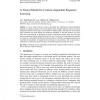141
Voted
BMCBI
2005
15 years 21 days ago
2005
Background: The alignment of multiple protein sequences is a fundamental step in the analysis of biological data. It has traditionally been applied to analyzing protein families f...
103
Voted
BMCBI
2005
15 years 21 days ago
2005
Background: Protein sequence motifs are by definition short fragments of conserved amino acids, often associated with a specific function. Accordingly protein sequence profiles de...
123
Voted
BMCBI
2005
15 years 21 days ago
2005
Background: Searching for approximate patterns in large promoter sequences frequently produces an exceedingly high numbers of results. Our aim was to exploit biological knowledge ...
131
Voted
TIP
2008
15 years 21 days ago
2008
In this paper, we present an automatic classification framework combining appearance based features and Hidden Markov Models (HMM) to detect unusual events in image sequences. One...
BIOINFORMATICS
2005
15 years 21 days ago
2005
: Recent advances in gene sequencing have provided complete sequence information for a number of genomes and as a result the amount of data in the sequence databases is growing at ...
87
Voted
TCS
2008
15 years 21 days ago
2008
We consider a large class of sequences, called admissible sequences, which are defined by systems of (possibly nonlinear) difference equations. A procedure for recursively enumera...
93
Voted
SIGPRO
2008
15 years 22 days ago
2008
Multiwindow Gabor representations highlight fingerprints suitable for indexing of macromolecules, based on their local periodic structures. This paper presents a technique for ana...
NPL
2006
15 years 23 days ago
2006
A novel neural network model is described that implements context-dependent learning of complex sequences. The model utilises leaky integrate-and-fire neurons to extract timing inf...
NAR
2006
15 years 23 days ago
2006
sgTarget (http://www.ysbl.york.ac.uk/sgTarget) is a web-based resource to aid the selection and prioritization of candidate proteins for structure determination. The system annota...



